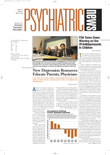The U.S. Food and Drug Administration (FDA) posted the final language for its new, required labeling of antidepressants last month, including the black-box warning and patient medication guide that must be dispensed with each prescription.
With no explanation, the FDA has significantly modified the wording describing the association between antidepressants and suicidal thoughts and behaviors.
In the final version of the warning, the first sentence in the black box has changed. The October draft's sentence initially read:“ Antidepressants increase the risk of suicidal thinking and behavior (suicidality) in children and adolescents with Major Depressive Disorder (MDD) and other psychiatric disorders.” The revised sentence limits the association between the two, more narrowly defining its scope. The sentence now reads: “Antidepressants increased the risk of suicidal thinking and behavior (suicidality) in short-term studies in children and adolescents with Major Depressive Disorder (MDD) and other psychiatric disorders.”
The change may be subtle, but it is significant. Even more significant is the deletion of a sentence from the first paragraph of text in the“ WARNINGS-Clinical Worsening and Suicide Risk” section of the label. The draft warnings posted by the agency last October read: “A causal role for antidepressants in inducing suicidality has been established in pediatric patients.” That sentence has been deleted from the final version of the new label and replaced with “Antidepressants increased the risk of suicidal thinking and behavior (suicidality) in short-term studies in children and adolescents with Major Depressive Disorder (MDD) and other psychiatric disorders.”
“This is clearly an important change,” said David Fassler, M.D., a child and adolescent psychiatrist and clinical associate professor of psychiatry at the University of Vermont School of Medicine. Fassler, an APA trustee, chaired the combined APA/American Academy of Child and Adolescent Psychiatry task force that developed the new resource<www.parentsmedguide.org>, which reviews the clinical trials data on the use of antidepressants in kids, and explains the FDA warnings (see story at
left).
“The change in wording,” Fassler continued, “brings the FDA warning closer to the actual science. I'm glad they responded to the extensive and detailed input from both practicing psychiatrists and the research community. Hopefully, the FDA will consider further revisions in the future, as more long-term and follow-up data become available.”
However, Darrel Regier, M.D., M.P.H., director of research at APA and executive director of the American Psychiatric Institute for Research and Education, emphasized, “We continue to be concerned about the use of the term `suicidality,' which the public widely equates with risk for completed suicides.”
It would have been more instructive, Regier said, had the FDA noted that there was no systematic monitoring for suidicality in some of the clinical trials it reviewed; thus, the only suicidal thoughts or behaviors that were noted were those that were spontaneously reported. In 17 of the 24 clinical trials reviewed, however, participants were directly questioned about suicidal thoughts or behaviors.
“We believe that additional research is necessary to determine how to evaluate both the systematic assessment and spontaneous adverse-event reports in these studies,” Regier said. “Such research should continue to inform recommendations coming from the FDA.”
The process that leads to the final approved language included in drug-product labeling is often convoluted, complicated, and intricate. Essentially the FDA and the drug company (which the FDA refers to as the“ sponsor” of the application for approval to market a drug) negotiate the final wording. In many instances the sponsor submits its own version of the wording for FDA approval. In the case of the antidepressant warnings, however, it was the FDA that had informed sponsors of the language it was proposing in October of last year.
While the FDA would not comment on what input shaped the final wording of the labeling, it is likely that the agency's staff in the Office of Drug Safety took primary responsibility for drafting the language. They may have taken into account input from the advisory committees; public comments; and written comments submitted by clinicians, researchers, and professional associations, including APA and AACAP, as well as others.
Revisions of draft language usually occur through a back-and-forth negotiation that ends with the ball in the FDA's court.
“Although every attempt is made to negotiate labeling with the sponsor,” noted FDA spokesperson Christine Parker, “the agency has the final say on the wording.”
Indeed, Parker told Psychiatric News, “In our January 12, 2005, and January 26, 2005, letters, we informed the sponsors that `Failure to make these changes within the specified period of time could make your product misbranded.' “ Drugs that are labeled misbranded no longer meet agency standards and thus lose marketing approval.
The new labeling was effective immediately upon issuance of the January 26 letter, Parker said. Sponsors were required to submit their individual revised product labeling to the FDA within 10 days, and all sponsors complied. However, weeks or even months may pass before patients see the new labeling.
“Stock on pharmacy shelves with the old labeling can be dispensed, and stock in distributors' warehouses with the old labeling can still be shipped to pharmacies,” noted Parker. The new labeling “will gradually make its way into the pharmacies over the next couple of months.”
Parker emphasized that “all Internet listings of the labeling would be expected to include the new labeling immediately.”
Medications with black-box warnings may continue to be advertised to both health care professionals and consumers, Parker noted.
“The body of the ads do not have to contain the box warning verbatim, but the body of the ad must include the information contained in the boxed warning, along with other important risk information about the product,” she explained. “Risk information, including the black-box warning, must be presented with comparable prominence to benefit information.”
The FDA's final versions of the warnings on antidepressants are posted online at<www.fda.gov/cder/drug/antidepressants/default.htm>.▪
